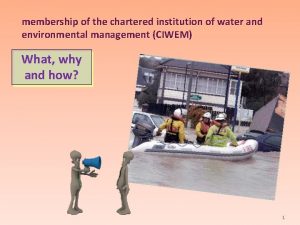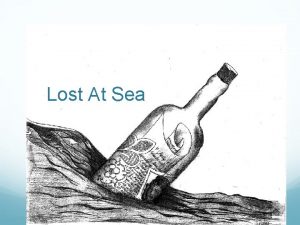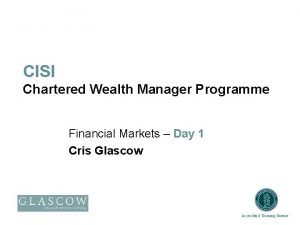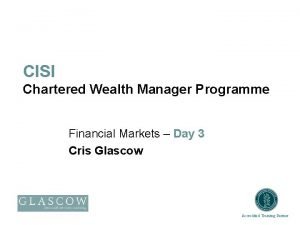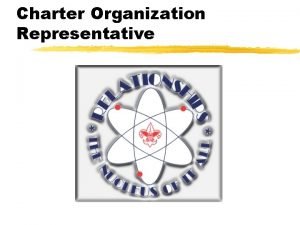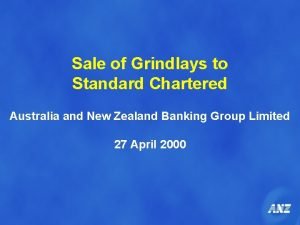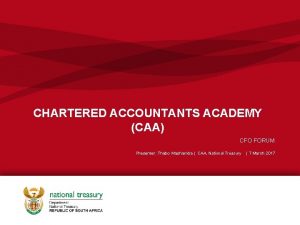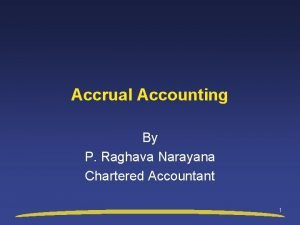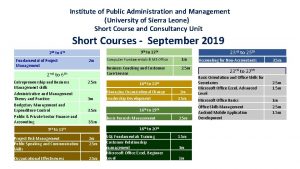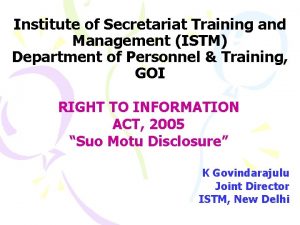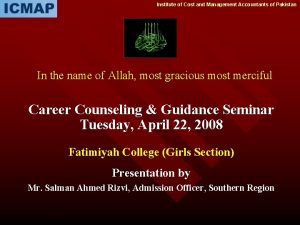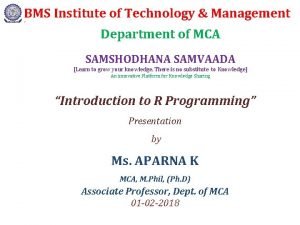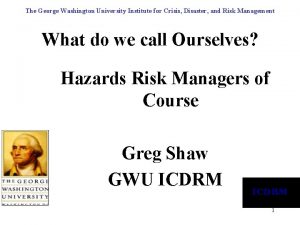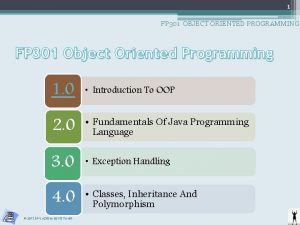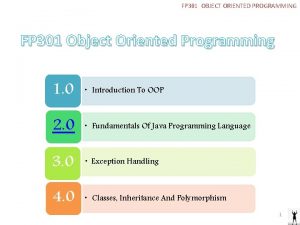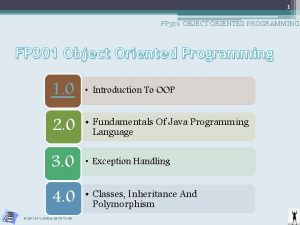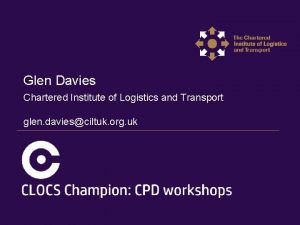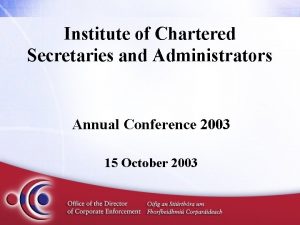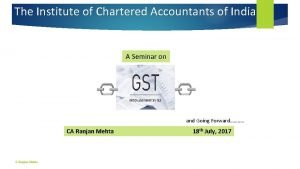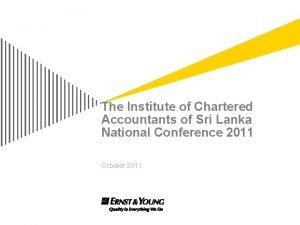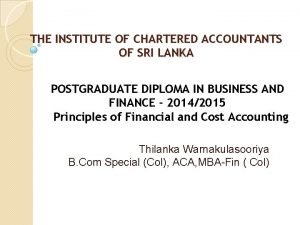Chartered Management Institute 301 Principles of Management and






























- Slides: 30

Chartered Management Institute 301 – Principles of Management and Leadership Learning Outcome 1 Understand How Organisations Operate Oxford Professional Education Group Ltd 1

Learning Outcome 1 1 - Understand how organisations operate: 1. 1 Outline the governance of different types of organisations Task 1 - Give three examples of different types of organisations and explain how each one is governed. 1. 2 Explain the factors which influence an organisation’s culture Task 2 a - Explain the factors which influence an organisation’s culture. 1. 3 Explain the purpose of organisational mission, vision and value statements Task 2 b - Explain the purpose of organisational mission, vision and value statements 1. 4 Outline the purpose of organisational strategies Task 2 c - Outline the purpose of organisational strategies. Oxford Professional Education Group Ltd 2

Types of Organisation Sole trader – owned by a single individual on a self-employed basis Partnerships – two or more individuals joining together to jointly own an organisation. Many legal firms or accountancies are owned jointly by multiple partners, whereas others may be two people who are, in effect, sole traders. Private limited companies (have ltd after their name) – these are owned by shareholders, possibly just one, but the shares are not publicly available. Public limited companies (have plc after their name) – these are also owned by shareholders but the shares can be bought publicly via stock markets. Because of the public nature of these organisations, greater transparency and visibility is required than those owned privately. Micro and small to medium sized enterprises (SME) – this relates to the size of the organisation rather than the ownership. Micro has less than 15 employees, small has up to 50 employees and medium can have up to 250 employees. Oxford Professional Education Group Ltd 3

Types of Organisation (2) Public sector - organisations owned by government or local authorities, representing the public. There also; Quasi-Autonomous National Government Organisations (QUANGOs) - UK examples include the Environment Agency and the Competition Commission. Public corporations (e. g. BBC) - state-owned industrial and commercial undertakings Municipal enterprises - providers of goods and services (e. g. museums, parks) run by local government authorities. Not-for-profit organisations – these are similar to the public sector but are likely to be owned by members or administered on behalf of the public, e. g. hospitals, universities, CMI. Charities would also be considered to be a not-for-profit organisation and are governed by the Charities Commission – a QUANGO. Third sector – private organisations providing a public sector service, e. g. church or community groups or trade unions. Oxford Professional Education Group Ltd 4

1. 1 Organisational Governance refers to the way organisations are controlled to ensure that they are managed in an appropriate way. It is the ‘managerial and directorial control of an organisation, which when well practiced can reduce the risk of fraud, improve company performance and leadership, and demonstrate social responsibility’ (Management Direct). The structure of the legislation surrounding corporate governance varies between countries. In the UK, the importance of good corporate governance was brought to public attention following a series of corporate collapses and scandals in the 1980 s and 1990 s. The effectiveness of the board of directors of the organisations involved was questioned, and the importance of independent, impartial non executive directors was highlighted. To address the issues raised, the Committee on the Financial Aspects of Corporate Governance was set up, chaired by Sir Adrian Cadbury. Following the publication of this committee’s report in 1992, a code of best practice was established. Although it is voluntary, all listed companies are expected to comply. Since the Cadbury report, a number of other committees have established best practice in specific areas, such as directors’ pay. These culminated in the Hampel committee, which established a Combined Code incorporating the Cadbury guidelines, Principles of Good Governance, and a Code of Best Practice. Oxford Professional Education Group Ltd 5

Public and Privately Owned Organisations This is what we traditionally think of when we think of 'companies'. The distinction between private and publicly-owned is whether a share can be bought in the company or not. Private companies can be a single individual tradesperson, or massive organisations, e. g. Virgin, Arcadia, JCB, Formula One, River Island. Shares cannot be publicly purchased in these organisations and they are called 'limited companies' or Ltd. Public companies are traded on stock markets so that people or institutions can buy a part of it, i. e. a share. They are often called plc's or Public Limited Companies. The terminology of plc and Ltd varies in different countries but the principle is the same, e. g. Sp. A is a plc in Spanish-speaking countries, the USA uses the term publicly-traded companies. Governance of both public and private companies is via a Board of Directors (which might only be two people) and there are strict legal and accounting conventions to follow. Oxford Professional Education Group Ltd 6

Membership Organisations In membership organisations such as the Chartered Management Institute, members pay a subscription and then, in effect, own a share of the organisation as a result. Building societies and co-operatives are classed as membership organisations. Membership organisations are governed by a Board of Trustees who oversee the collection and usage of funds, and the activities they are used for. Trustees will usually be voted for by the members, based on who they feel best represents their interests. Membership organisation still have to follow accounting and governance standards like every other organisation. Oxford Professional Education Group Ltd 7

Not-for-profit (NFP) Organisations NFPs cover a wide variety of different types of organisations, from universities and hospitals to government organisations and charities. Their aim is to generate something other than for profit for an owner, e. g. cultural enrichment, support, service delivery, medical research, etc. Even though their focus isn't profit for an owner, their revenue still needs to exceed their costs but the revenue often comes from funding such as grants and donations, rather than commercial activities in competitive environments. Although they may use commercial activities for revenue generation, there is often a conflict between this and the delivery of their purpose, i. e. where the balance should sit. Governance is similar to membership organisations in that they have an elected (or appointed) Board of Trustees and still have to follow accounting conventions. Oxford Professional Education Group Ltd 8

The Focus of the Boardroom The Board of Directors or other governing body have responsibilities towards an organisation and this indicates how they look at things. So for a new proposal, for example, they may focus on the following areas: How much will it cost? Their responsibilities include ensuring that the organisation can afford it or is able to raise the funds in an efficient way. What will the return be? The job of members of the governance board is to make money for the owners or deliver the organisation's purpose (such as a charity) so they focus on what a proposal will generate. What are the risks? As well as revenue generation, their responsibility is to ensure survival so they need to be aware of potential risks so that they can be taken into consideration. What are the wider implications? Proposals tend to come from a department which means they are likely to be blinkered. The governing body can take an overall view of the whole organisation for a bigger picture. Oxford Professional Education Group Ltd 9

Fiduciary Duties and Roles An organisation's governing body has 'fiduciary duties', i. e. a legal duty of care to look after someone else's money and interests. Each member of the governing board has to accept their role in upholding these duties. So they would have to avoid, for example, a conflict of interests. Members of the governing body are usually called 'directors' or 'trustees', depending on the type of organisation. The language is significant as it explains, for example, the difference between a Managing Director and a Chief Executive. A Chief Executive is an employee recruited to do a job. A Managing Director has a fiduciary duty towards the organisation on behalf of the owners and thus will have a place on the Board. Directors who are also employees are called Executive Directors. Members of the board may be recruited in an advisory capacity and bring experience in an area - they are called Non-Executive Directors (NEDs) if they don't have a specific job within the organisation. Oxford Professional Education Group Ltd 10

Non-Executive Directors and Trustees NEDs bring a degree of impartiality and experience not available to employees. They may be highly experienced in the field, or alternatively they may bring investment to the organisation and thus want to influence its direction. A not-for-profit organisation also has a governing body but the directors are normally called Trustees and the governing body is the Board of Trustees. Their roles are the same as Directors but with a focus on the good of the organisation or members, rather than revenue generation as it would be for a profit-driven enterprise. Membership organisations, such as the CMI, often have elected trustees to ensure that the voice and needs of members is represented on the Board. A Chairman is a member of the governing body so it is good practise to separate the Chairman's role from that of the MD or Chief Executive to ensure they maintain an overarching view of the organisation, rather than being affected by day-to-day requirements or influences. Oxford Professional Education Group Ltd 11

1. 2 Organisational Culture can be defined as the way organisations do things and the way it thinks. It is a pervading attitude and set of behaviours. It can be considered as ‘the combined beliefs, values, ethics, procedures and atmosphere of an organisation … and consists of largely unspoken values, norms and behaviours that become the natural way of doing things. ’ (Management Direct) An organisation's culture may also be more apparent to an external observer than an internal practitioner. When thinking about culture, there are some models which provide details of the components with which to analyse it, and others that give categories into which a culture can be placed. Oxford Professional Education Group Ltd 12

Models of Organisational Culture A useful model of the factors which constitute culture is Johnson & Scholes’ cultural web which consists of Stories & Myths, Rituals and Routines, Symbols, Power Structures, Control Systems, and Organisational Values. Analysing each of these gives guidance on what the culture is. The culture can also be changed by altering one of these components. For example, if a contact centre assesses staff on how many calls they answer, staff will focus on ending the call as quickly as possible. But if the assessment is based on satisfaction survey results, they will spend longer with each caller and thus their behaviour will change. The cultural web is often illustrated diagrammatically as shown on the next slide. Oxford Professional Education Group Ltd 13

The Cultural Web Symbols Stories and Myths Heroes and bad guy stories symbolising what the organisation is about • Logos offices, cars, titles, language, etc Power Structures Powerful groups Paradigm Core beliefs, assumptions, values Org Structures Rituals • The way we do • Formal ways of things around here, working, Control • things taken for • Signal what is Systems granted important Measurement and • promotional reviews, reward systems that etc signal what is important Source; Johnson (1992) Oxford Professional Education Group Ltd 14

Categorising an Organisational Culture Having analysed the individual components of culture, it can help to categorise the culture by putting it into a box which explains the type. For example, Handy’s model of culture outlines four types of culture: Role culture – everyone has their role to play and if everyone follows the role, everything will work smoothly. For example, a fast food kitchen or a factory production line. Power culture – everything needs to go through, and be decided by, the seat of power such as an individual business owner or a powerful department such as Finance. Task culture – in this approach, it doesn’t matter who does a task, so long as the job gets done. An example would be an advertising agency or a film production company where the Chief Executive may be making the tea whilst more junior staff are busy producing creative materials as they have a deadline. People culture – this would have a strong emphasis on empowering staff and giving them freedom. Google is an example as staff are given time during work hours to develop their own personal projects and ideas. This approach is also shown diagrammatically on the next slide. Oxford Professional Education Group Ltd 15

Handy's Model of Different Cultures Power Culture Very bureaucratic and top-down. “I’m the boss” Task Culture It doesn’t matter who does it or how, just get it done Role Culture Everyone has a job to do and it will be fine so long as everyone does it correctly Person culture Support and empower everyone to bring out the best of their abilities Adapted from Palmer & Hartley, Business Environment, 5 e 2006 Oxford Professional Education Group Ltd 16

1. 3 Mission, Vision and Value Statements A mission is a ‘short, memorable statement clarifying the reasons for the existence of an organisation, expressing what its purpose is'. (Management Direct) A vision gives a broader, more inspirational image of the future of an organisation and what it aspires to be. It tries to translate a mission into what achievement of it might look like in reality. Values are what the organisation aims to live by, e. g. the standards of behaviour by which it wishes to comply. There are two types: Core values - these are distinctive, deeply ingrained and govern all of an organisation's actions. They articulate what fundamentally matters to an organisation and are a key driver of strategic purpose alongside the vision and the mission. Aspirational values – these are what people think will be needed to succeed in the future but may not yet be embedded in practice. Missions, visions and values are often given as statements that employees can read, understand follow. The act of writing the statements can also make the organisation think about what is important to it. Oxford Professional Education Group Ltd 17

Developing a Mission Some areas to consider when developing mission and values include; • Influences, e. g. internal and external, obtained from a thorough strategic audit • Abilities and competencies – both what the organisation currently has and what it strives to have. • The overall values of the organisation, e. g. whether it is aggressive or entrepreneurial • The relevant stakeholders and their respective power and influence levels • The ability to plan for the future, i. e. whether it is possible to forecast the future for a market • Overall aims and a vision of where the organisation wants to be • A definition of the market it wants to be in and a description of the customer targets • How it intends to compete and be better than competitors, i. e. its potential sources of competitive advantage • Boundaries – what it’s interested in doing and what it isn’t (known as the 'scope') Oxford Professional Education Group Ltd 18

Examples of Dominant Values Organisation type Dominant values Commercial Profit (returns to owners) differences in FMCG and B 2 B, Capital projects Charity Service or support to beneficiaries Public sector Service to community SME Survival – limited marketing resources and techniques The dominant values will help to determine the mission and vision of the organisation Oxford Professional Education Group Ltd 19

Considerations When Developing a Mission Internal Broad Scope Narrow General role; What sort of organisation do we want to be? Values • What do we see as important? • How should our people behave? • What do we want to be known for? Focus External Domain; • Where can we operate effectively • Where do we want to operate? Critical Success Factors What are we good at? What are we bad at? How are we perceived? What can we do strengthen or leverage our position? This table shows the areas to be considered when deciding on a mission, i. e. whether the focus needs to be external or targeted at the internal staff and structure, and whether the organisation will have a broad or narrow scope. The table provides a number of questions to ask, the answers to which will provide guidance on what should be in the organisation’s mission. Source; Wilson & Gilligan (2005) adapted from Piercy (1997) Oxford Professional Education Group Ltd 20

Potential Scopes of Missions • Narrow or broad focus – should the organisation focus on a particular item (trains) or a broader service (transport)? • Product or Market – ‘we sell widgets’ or ‘we service customers wanting the benefits of widgets’. • Stakeholders – which ones will the organisation concentrate on, e. g. customers, shareholders, employees, society, etc. • Geographic – local, national or international? Oxford Professional Education Group Ltd 21

Visioning A vision gives more detail on the mission and shows what it might actually look like for those who have to deliver it. It could include: • Targeted size in 3, 5 or 10 years time • Image and reputation that will have been created • Corporate and brand values that will have been developed • Nature of the customer base and segments • How these customers should perceive the organisation • The targeted geographic coverage • Position within market and competitive stance • Links and partnership approaches with other organisations Source; Wilson & Gilligan (2005) Oxford Professional Education Group Ltd 22

Examples of Missions “e. Bay's mission is to provide a global trading platform where practically anyone can trade practically anything. “ Ebay "We create happiness by providing the finest in entertainment for people of all ages, everywhere. “ Disney “Our Mission; Making life easier for people with intimate needs Our values; Closeness. . . to better understand Passion. . . to make a difference Respect and responsibility. . . to guide us Our vision; Setting the global standard for listening and responding” Oxford Professional Education Group Ltd Coloplast 23

What Makes a Good Mission and Vision? According to Abell (1980), a successful mission should pass these six tests; 1. Be specific enough to have an impact on the behaviour of staff throughout the organisation 2. Be founded more on customer needs and their satisfaction than product characteristics 3. Reflect the organisation’s core skills 4. Reflect opportunities and threats 5. Be attainable 6. Be flexible Source; Wilson & Gilligan 2005 Oxford Professional Education Group Ltd 24

1. 4 Strategy is the overarching approach taken by an organisation to deliver its goals. It arises from the mission and is the method used to achieve it. It helps an organisation know which customers it is targeting, the products and services to use with them, and the subsequent resources and skills required. A strategy can create the direction and structure needed by staff to know how to do their jobs in line with what the organisation is trying to achieve. There are many models of strategy which show broad approaches that an organisation can use, such as the Ansoff Matrix or Porter's Generic Strategies. The organisation would then pick an approach as its driving philosophy and all activity it undertakes would be in line with this. Oxford Professional Education Group Ltd 25

Ansoff Matrix New Market development -New markets for existing products Diversification -New products & new markets Market Penetration -Increase Market Share The principle behind the Ansoff matrix is that organisations can either focus on creating new products, and/or finding new markets. These two broad options then create a 2 x 2 matrix with the strategy being whichever box the organisation's approach fits in. Product development -Improve the products in an existing market Existing Products New Source; Ansoff (1957) Oxford Professional Education Group Ltd 26

Porter's Generic Strategies Decreasing audience size Niche markets Differentiation Rising costs The Death Zone Cost leadership Oxford Professional Education Group Ltd Porter states that organisations can seek to either differentiate themselves from competitors or pursue internal cost savings. They can also choose whether to seek a wide audience or be more focused on a narrower area. To large extent, it doesn't matter which route is chosen so long as it is clear, otherwise the organisation may end up in Death Zone where it doesn't fulfil any needs sufficiently. 27

Different Perspectives on What a Strategy is Mintzberg (1987) outlines five different perspectives of what a strategy is, categorised as the 5 Ps: • Plan – the output of a systematic planning process, e. g. analysis, objectives, options, implementation • Ploy – the process of out-manoeuvring competitors to gain advantage • Pattern – a stream of actions adopted consistently over time, creating an emergent, incremental approach to strategy development • Position – identifying the competitive position of an organisation and shaping a response accordingly • Perspective – a way of viewing the world, creating a corporate culture and personality. Oxford Professional Education Group Ltd 28

Next Learning Steps The College has provided a Learning Journey in Management Direct which will help you understand more about the topics covered in this session. When you have spent time with each area, attempt the activities we have provided. When you are comfortable that you understand this area, move on to the next Learning Outcome. Oxford Professional Education Group Ltd 29

Bibliography Handy, C. (1993) Understanding Organisations. Penguin. Hooley, G. , Piercy, N. , Nicolaud, B. (1997) Marketing Strategy and Competitive Positioning. London, FT/Prentice-Hall. Johnson, G. , Scholes, K. (2002) Exploring Corporate Strategy. 6 th edition. London, FT/Prentice-Hall Mintzberg, H. (1993). The Rise and Fall of Strategic Planning. Pearson Education Limited Palmer, A. , Hartley, B. (2001) The Business Environment. Maidenhead, Mc. Graw-Hill Porter, M. E. , (2004) Competitive Advantage. New York, Free Press. Schein, E. (2010) Organizational Culture and Leadership. 4 th edition. San Francisco, Jossey-Bass. Wilson, R. M. S. , Gilligan, C. (2005). Strategic Marketing Management; Planning, Implementation & Control. Oxford, Butterworth-Heinemann. Oxford Professional Education Group Ltd 30
 Ciwem membership
Ciwem membership Dilignece
Dilignece The hong kong institute of chartered secretaries
The hong kong institute of chartered secretaries Chartered developments
Chartered developments Grahame knox lost at sea
Grahame knox lost at sea Initial professional development
Initial professional development Chartered wealth manager cisi
Chartered wealth manager cisi Formula accrued interest
Formula accrued interest Applied wealth management
Applied wealth management How to become a chartered geologist
How to become a chartered geologist Chartered scientist
Chartered scientist Bcs professional member
Bcs professional member What is a charter organization
What is a charter organization Standard chartered australia
Standard chartered australia Chartered secretaries southern africa
Chartered secretaries southern africa Chartered project professional
Chartered project professional International professional engineer
International professional engineer Cipd experience assessment examples
Cipd experience assessment examples Term and reversion valuation
Term and reversion valuation Chartered accountants academy
Chartered accountants academy Accrue chartered accountants
Accrue chartered accountants Institute of public administration and management
Institute of public administration and management Institute of supply and materials management
Institute of supply and materials management Institute of secretariat training and management
Institute of secretariat training and management Institute of cost and management accountants of pakistan
Institute of cost and management accountants of pakistan Bms institute of technology and management
Bms institute of technology and management George washington crisis management
George washington crisis management Swami vivekanand institute of technology and management
Swami vivekanand institute of technology and management Clase de adrese ip
Clase de adrese ip Diketahui log 3 = 0 477
Diketahui log 3 = 0 477 Coe 301 kfupm
Coe 301 kfupm
